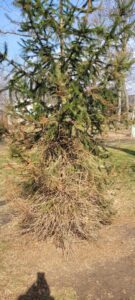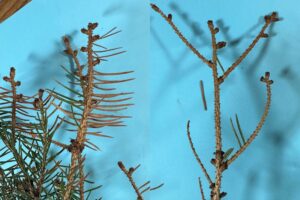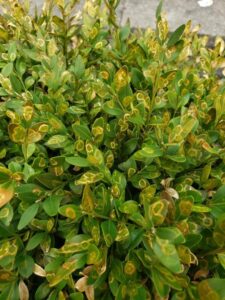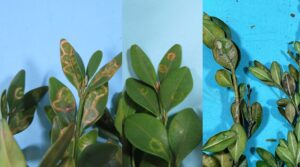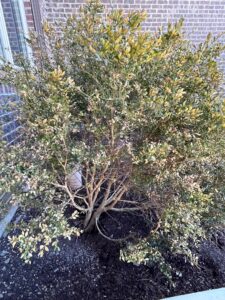There have been a number of samples we have received at the PPDL in recent weeks that bear similar problems worth noting. It is still relatively early for significant in-season disease development due to how cold it has been, although we have certainly had enough rainfall to encourage fungal growth. We have received multiple samples of spruce and boxwood which will be covered.
Since the start of the year, we have been received spruce samples showing needle thinning, browning, and loss in the lower canopy (Fig 1, 2, 3). If I said these are Colorado Blue Spruce, we could call it Rhizosphaera and maybe call it a day, however, these samples are primarily from other species of spruce. An important thing to remember when it comes to evergreen conifers is that it takes time for symptoms to develop, whether due to disease or to abiotic factors. The majority of these branches lacked any discoloration within, suggesting that there was no infection and that the limbs were still living.
- Figure 1: A spruce tree showing significant needle loss and dieback lower in the canopy.
- Figure 2: Needle loss at or near branch tips.
- Figure 3: Close up of needle browning and loss near spruce branch tips.
Last year, we had drought conditions during the summer throughout large parts of the state leading into the fall with below average precipitation (Fig 4). Since evergreen plants hold onto their foliage through the winter, desiccation can occur since they are still losing water to the air, especially when it is dry and windy. If these plants are not getting enough water going into winter, there is greater risk of winter injury or burn and needles may turn brown, especially near branch tips (exposed areas).

Figure 4: Indiana Precipitation data, in inches of rainfall, from 2019 to present. Courtesy of Midwest Regional Climate Center – cli-Mate: https://mrcc.purdue.edu/CLIMATE/
Irrigation during periods of hot and dry weather will mitigate drought stress, but irrigation may still be necessary in the fall to avoid needle desiccation. What about when trees of the same age, on the same property are showing different levels of severity or one tree is perfectly fine while the next is toast?
I think it is important to remember each tree is an individual. We may see similar patterns in the landscape across the same tree species when stress is caused by environmental effects, but if the overall health of that tree when it was first planted, the amount of love and care, and the site conditions (soil, light, general water levels) are different, then the trees may have vastly different reactions to stress. Determining this 5 years after planting can be difficult for someone just walking into the situation, or when dealing with 30ft tall trees, but it is something we have to keep in mind.
We have also been receiving boxwood samples with yellow ringspots on the leaves (Fig 5, 6). While people may not see this damage until the leaves are turning brown or fall off the tree (Fig 7), this is a symptom of active feeding by the boxwood leafminer and can be quite striking. The maggot feeds within the leaves and causes the leaf to bubble-out where these blotch-like leaf mines are located. This year there have been anecdotal reports of seeing early leafminer activity, which could be associated with the milder winter we have had in the Midwest. We typically see leaf miner activity starting later in the year and that the damage often goes undetected by homeowners until much later in the season.
- Figure 5: Yellow ringspots on boxwood foliage. Photo Credit: Jeff Pell, Agriculture and Natural Resources Educator, Hendricks County
- Figure 6: Blotch-like leaf mines caused by the larvae of the boxwood leaf miner.
- Figure 7: Boxwood leaf miner injury across an entire boxwood plant which will lead to defoliation.
Additional Resources
https://www.purduelandscapereport.org/article/still-time-to-fight-back-against-boxwood-leafminer/
